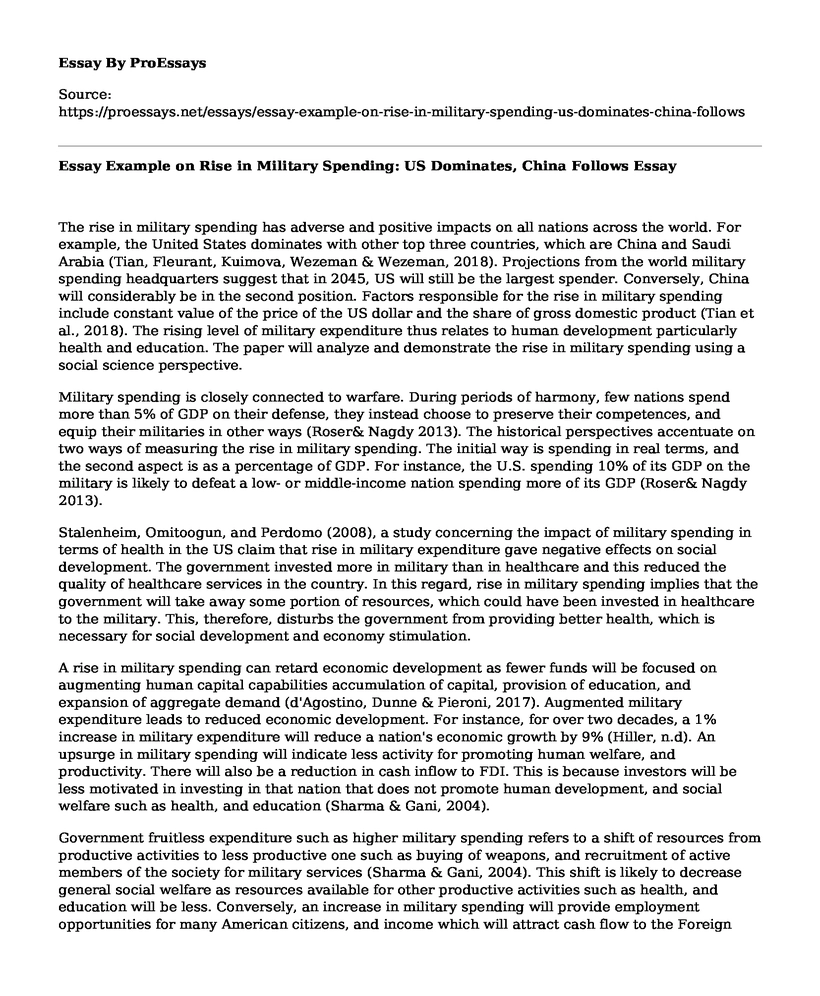The rise in military spending has adverse and positive impacts on all nations across the world. For example, the United States dominates with other top three countries, which are China and Saudi Arabia (Tian, Fleurant, Kuimova, Wezeman & Wezeman, 2018). Projections from the world military spending headquarters suggest that in 2045, US will still be the largest spender. Conversely, China will considerably be in the second position. Factors responsible for the rise in military spending include constant value of the price of the US dollar and the share of gross domestic product (Tian et al., 2018). The rising level of military expenditure thus relates to human development particularly health and education. The paper will analyze and demonstrate the rise in military spending using a social science perspective.
Military spending is closely connected to warfare. During periods of harmony, few nations spend more than 5% of GDP on their defense, they instead choose to preserve their competences, and equip their militaries in other ways (Roser& Nagdy 2013). The historical perspectives accentuate on two ways of measuring the rise in military spending. The initial way is spending in real terms, and the second aspect is as a percentage of GDP. For instance, the U.S. spending 10% of its GDP on the military is likely to defeat a low- or middle-income nation spending more of its GDP (Roser& Nagdy 2013).
Stalenheim, Omitoogun, and Perdomo (2008), a study concerning the impact of military spending in terms of health in the US claim that rise in military expenditure gave negative effects on social development. The government invested more in military than in healthcare and this reduced the quality of healthcare services in the country. In this regard, rise in military spending implies that the government will take away some portion of resources, which could have been invested in healthcare to the military. This, therefore, disturbs the government from providing better health, which is necessary for social development and economy stimulation.
A rise in military spending can retard economic development as fewer funds will be focused on augmenting human capital capabilities accumulation of capital, provision of education, and expansion of aggregate demand (d'Agostino, Dunne & Pieroni, 2017). Augmented military expenditure leads to reduced economic development. For instance, for over two decades, a 1% increase in military expenditure will reduce a nation's economic growth by 9% (Hiller, n.d). An upsurge in military spending will indicate less activity for promoting human welfare, and productivity. There will also be a reduction in cash inflow to FDI. This is because investors will be less motivated in investing in that nation that does not promote human development, and social welfare such as health, and education (Sharma & Gani, 2004).
Government fruitless expenditure such as higher military spending refers to a shift of resources from productive activities to less productive one such as buying of weapons, and recruitment of active members of the society for military services (Sharma & Gani, 2004). This shift is likely to decrease general social welfare as resources available for other productive activities such as health, and education will be less. Conversely, an increase in military spending will provide employment opportunities for many American citizens, and income which will attract cash flow to the Foreign Direct Investment through potential investors.
Conclusion
In conclusion, the rise of military spending is considered a government burden despite the fact that it has positive effects on some countries and at the same time negative effects on human development. However, the rise in military expenditure can build human capital if the resources are used for training the military on discipline. Countries across the globe continue to increase their military spending whether they are in war or not because it is important for them to maintain a military capacity.
References
d'Agostino, G., Dunne, J. P., & Pieroni, L. (2017). Does military spending matter for long-run growth?. Defence and Peace Economics, 28(4), 429-436. Retrieved from: https://www.tandfonline.com/doi/abs/10.1080/10242694.2017.1324723
Hiller, P. The Effects of Military Spending on Economic Growth. Retrieved from: https://peacesciencedigest.org/effects-military-spending-economic-growth/
Roser, M., & Nagdy, M. (2013). Military Spending. Our World in Data. Retrieved from: https://ourworldindata.org/military-spending
Sharma, B., & Gani, A. (2004). The effects of foreign direct investment on human development. Global economy journal, 4(2), 1850025. Retrieved from: file:///C:/Users/User/Downloads/sug189.pdf
Stalenheim, P., Omitoogun, W. U. Y. I., & Perdomo, C. A. T. A. L. I. N. A. (2008). Appendix 8A. Tables for military expenditure. SIPRI YEARBOOK, 2005, 345. Retrieved from: https://www.sipri.org/sites/default/files/YB06%20295%2008.pdf
Tian, N., Fleurant, A., Kuimova, A., Wezeman, P. D., & Wezeman, S. T. (2018). Trends in world military expenditure, 2017. Stockholm International Peace Research Institute. Retrieved from: https://sipri.org/sites/default/files/2019-04/fs_1904_milex_2018_0.pdf
Cite this page
Essay Example on Rise in Military Spending: US Dominates, China Follows. (2023, Feb 23). Retrieved from https://proessays.net/essays/essay-example-on-rise-in-military-spending-us-dominates-china-follows
If you are the original author of this essay and no longer wish to have it published on the ProEssays website, please click below to request its removal:
- Cultural Competence Through Multiculturalism Essay Example
- Essay on Nurse Practitioners: Impact of Regulatory Policies on Advanced Practice Nursing
- Essay Sample on Facing Challenges: Analysis of 'The Canadian Journal of Sociology'
- Essay Example on Brexit Deal: Johnson Aims for UK Control, Flexibility at Cost
- U.S. Government: A Dynamic Political System of 3 Branches - Essay Sample
- Essay Example on Electoral Security Matters: US 2020 Elections & Beyond
- Chinese Scientist 'Playing God': Ethical Debate Over Creation of HIV-Resistant Babies - Free Paper Sample







